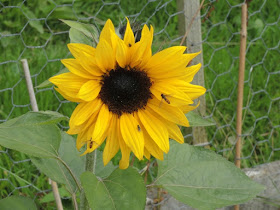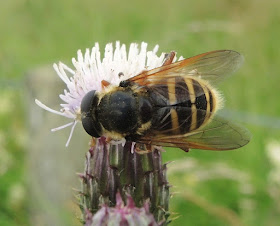Sunflower and Episyrphus balteatus
Two Episyrphus balteatus and a Syrphus sp on the crucifer
Female Eupeodes corollae on the flowers (id the yellow runs across the margin from upper to lower body surface).
Female Syrphus, either vitripennis or torvus, to get to species level need to see the extent of the tiny hairs on the 2nd basal cell of the wing, a microscope job.
Out and about down the track and around the Wee Wood there have been huge numbers of hovers. Cheilosia illustrata has just begun to be seen in some numbers. It is a small and not especially good mimic of bumblebees.
Cheilosia illustrata on Hogweed
Most hovers were on Creeping thistle heads.
Creeping Thistle by the side of the track
I counted 139 Helophilus pendulus between the Weee Wood and the hawthorn hedge, but there were 100s more than that I suspect.
Helophilus pendulus mating
H.hybridus, pair mating and Empis livida
Syritta pipiens showing the enlarged hind femur
Syritta pipiens and thing (LJ can you get that to family?)
Sericomyia silentis a wasp mimic
Male Platycheirus manicatus, front tarsi enlaged, dull thoracic dorsum, yellow/orange and black
Female of the same species showing the sticking out face (females do not have enlarged tarsi).
There have been some good moths lately as well, I'll post them shortly.
Windy and quite wet here today, not much good for insects but I got a new bike the other day, well I've had the Kona for 26 years so I don't think I'm being too extravagant and got a good deal via the Cyclescheme (tax free (ish) purchase). So time to get muddy...
Windy and quite wet here today, not much good for insects but I got a new bike the other day, well I've had the Kona for 26 years so I don't think I'm being too extravagant and got a good deal via the Cyclescheme (tax free (ish) purchase). So time to get muddy...















Wow, Alastair, I didn't realise that there were so many different species of hover up here. Nice pics!
ReplyDeleteThanks GW
ReplyDeleteWow the hovers are busy. Not seen any footballers or hornet mimics this year - they are real beasties!
ReplyDelete